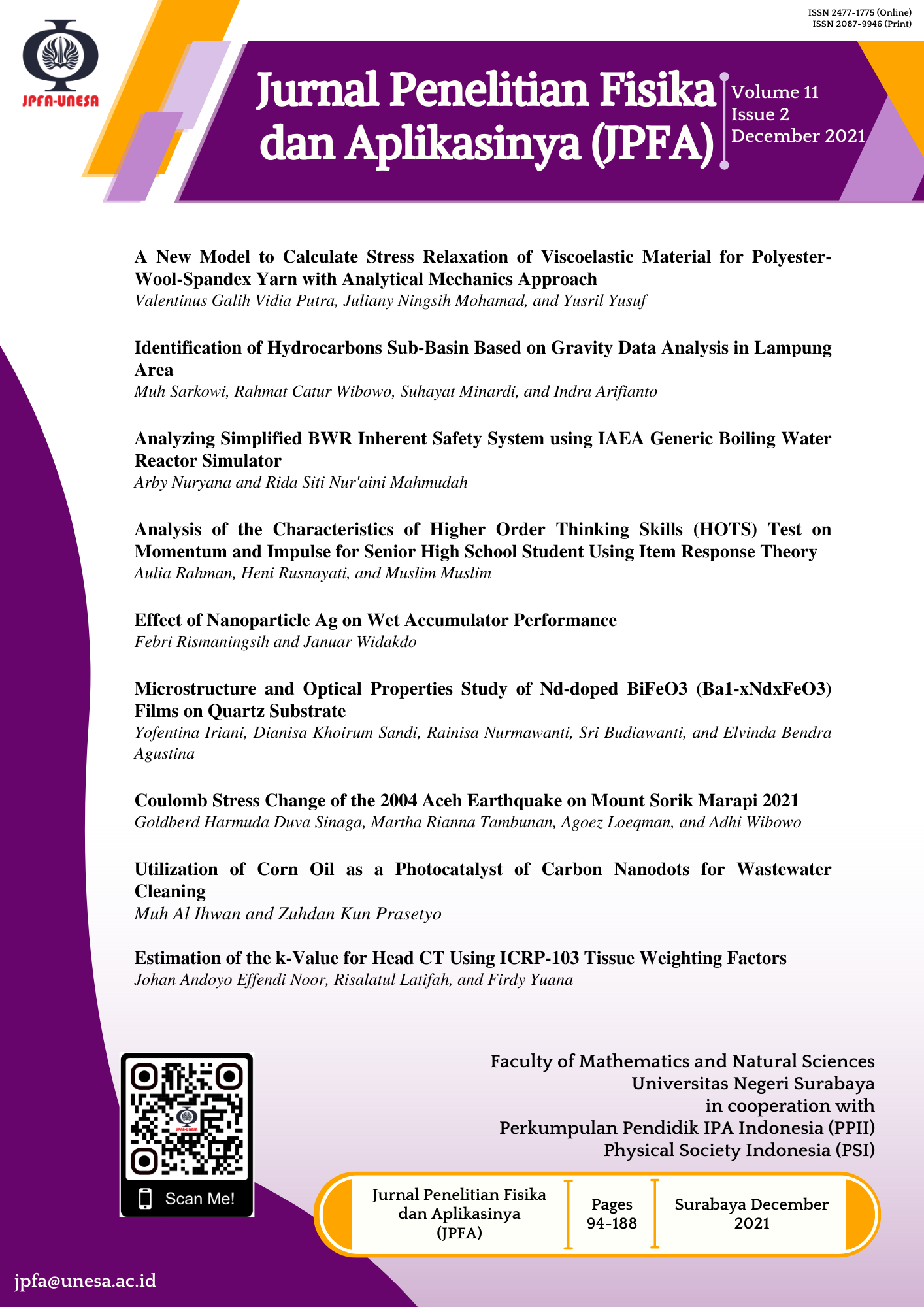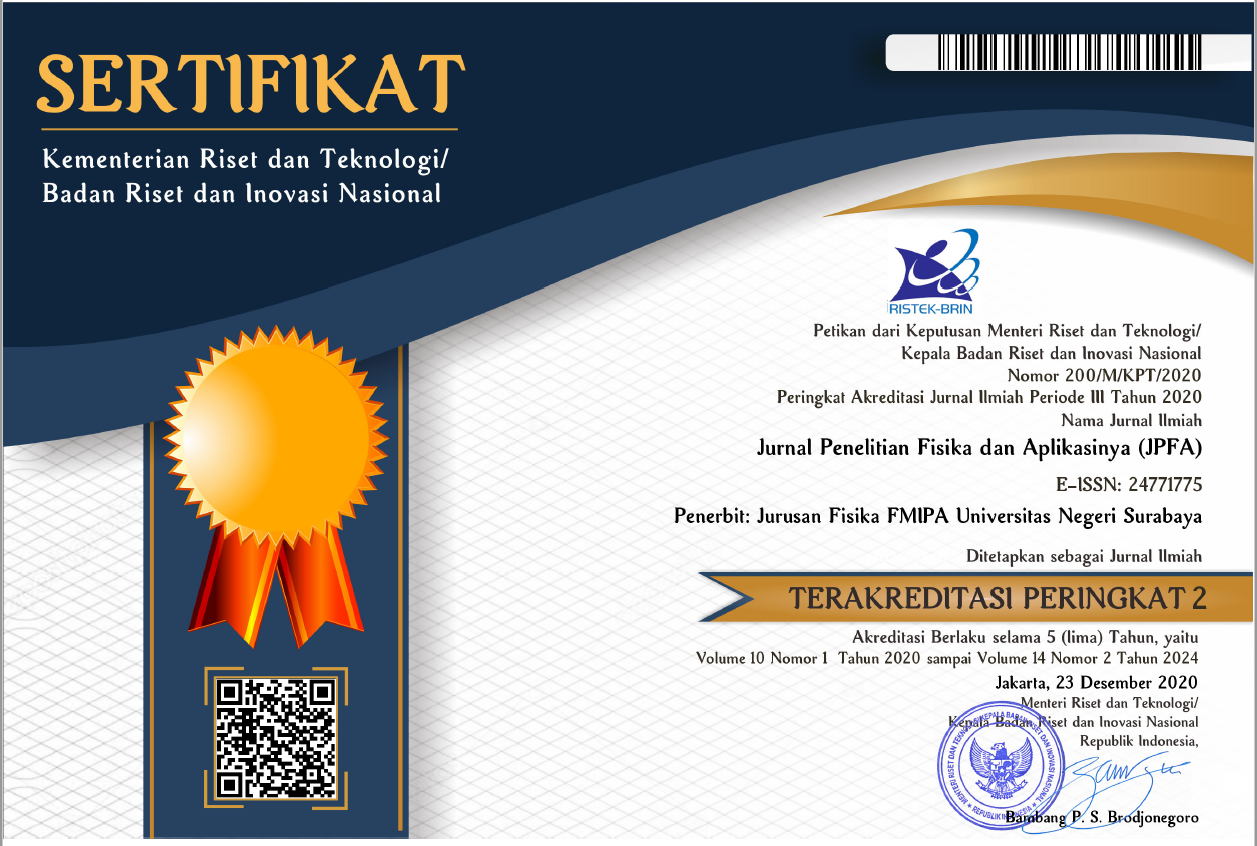Coulomb Stress Change of the 2004 Aceh Earthquake on Mount Sorik Marapi 2021
DOI:
https://doi.org/10.26740/jpfa.v11n2.p158-170Keywords:
Earthquake, Sumatera, coulomb stress, SorikmarapiAbstract
Sorik Marapi is an active volcanic mountain with an altitude of 2,145 meters located in Batang Gadis National Park, Sibanggor Julu Village, Mandailing Natal Regency, North Sumatra, Indonesia. Since the earthquake in Aceh on December 26, 2004, geological conditions in the western part of Sumatra Island have increased in stress. This affects the volcano in Sumatra, Mount Sorik Marapi, so it needs to be studied to find out the condition of changes in coulomb stress in Sorik Marapi. The method used in this study is a descriptive method with an analysis of the coulomb stress method. From the Aceh earthquake year of December 2004 to 2021, Mount Sorik Marapi experienced the highest average increase in coulomb stress in 2012, which was 0.171 bars. The highest average increase in shear in 2015 was 0.25 bars, and the highest average normal increase in 2018 was 0.202 bars. While at depth, Sorik Marapi mountain experienced an average change in coulomb stress highest of 0.368 bars, the average increase in the highest shear by 0.269 bars, and the average normal increase of 0.246 bars. All such increases are at a depth of 90 km below sea level. Based on the results of this study, it is stated that Mount Sorik Marapi experiences inconsistent changes in coulomb stress every year.
References
Sagala BD, Chandra VR, and Purba DP. Conceptual Model of Sorik Marapi Geothermal System Based on 3-G Data Interpretation. 5th Proceedings of ITB International Geothermal Workshop. Bandung: ITB; 2016: 39-46.
Carver C and Hidayat R. The Fluid Geochemistry of the Sorik Marapi Geothermal Reservoir. GRC Transactions. 2020; 44: 658-664. Available from: https://publications.mygeoenergynow.org/grc/1034244.pdf.
Barber AJ, Crow MJ, and Milsom JS. Sumatera: Geology, Resources and Tectonic Evolution. London: Geological Society; 2005.
Mulyani S, Sarmiento Z, Chandra V, Hendry R, Nasution S, Hidayat R, Jhonny J, Sari P, and Juandi D. Calibrated Natural State Model in Sorik Marapi Geothermal Field, Indonesia. International Petroleum Technology Conference 2019. Beijing; 2019. DOI: https://doi.org/10.2523/iptc-19221-ms.
Panjaitan LM, Fattah EI, Suhendi C, Wulandari R, and Pekasa HY. Analisis Pergerakan Dan Akumulasi Coulomb Stress Gempa Utama Lombok Selama Tahun 2018 dan Pengaruhnya Terhadap Aktivitas Gunung Rinjani. Jurnal Meteorologi Klimatologi dan Geofisika. 2020; 7(1), 38-42. DOI: https://doi.org/10.36754/jmkg.v7i1.215.
Sinaga GHD, Zarlis M, Sitepu M, Prasetyo RA, and Simanullang A. Coulomb Stress Analysis of West Halmahera Earthquake mw=7.2 to Mount Soputan and Gamalama Volcanic Activities. IOP Conference Series: Earth Environmental Science. 2017; 56(1): 012005. DOI: https://doi.org/10.1088/1755-1315/56/1/012005.
Puspasari F and Wahyudi W. Distribusi Coulomb Stress Akibat Gempabumi Tektonik Selatan Pulau Jawa berdasarkan Data Gempa Tektonik 1977-2000. Jurnal Fisika dan Aplikasinya. 2017; 13(2): 74-77. DOI: https://doi.org/10.12962/j24604682.v13i2.2745.
Ardiansyah S. Kajian Hubungan Antara Distribusi Gempa Susulan Aceh 26 Desember 2004 Terhadap Distribusi Perubahan Tekanan Coulomb (Coulomb Stress Change). Megasains. 2013; 4(3): 133-139. Available from: https://gawbkt.id/assets/data/Megasains-PDF/PDF/2013-Vol%203%20Megasains.pdf.
Nostro C, Stein RS, Cocco M, Belardinelli ME, and Marzocchi W. Two-way Coupling Between Vesuvius Eruptions and Southern Apennine Earthquakes, Italy, By Elastic Stress Transfer. Journal of Geophysical Research: Solid Earth. 1998; 103(B10): 24487-24504. DOI: https://doi.org/10.1029/98JB00902.
De Natale G, Petrazzuoli SM, Troise C, Pingue F, and Capuano P. Internal stress field at Mount Vesuvius: A Model For Background Seismicity at A Central Volcano Background Seismicity at A Central Volcano. Journal of Geophysical Research: Solid Earth. 2000; 105(B7): 16207-16214. DOI: https://doi.org/10.1029/2000JB900031.
Qiu Q and Chan CH. Coulomb Stress Perturbation After Great Earthquakes in The Sumatran Subduction Zone: Potential Impacts in The Surrounding Region. Journal of Asian Earth Sciences. 2019; 180: 103869. DOI: https://doi.org/10.1016/j.jseaes.2019.103869.
Toda S, Stein RS, Sevilgen V, and Lin J. Coulomb 3.3 Graphic-Rich Deformation and Stress-Change Software for Earthquake, Tectonic, and Volcano Research and Teaching-User Guide. Virginia: U.S. Geological Survey; 2011. Available from: https://pubs.usgs.gov/of/2011/1060/.
Cocco M and Rice JR. Pore Pressure and Poroelasticity Effects in Coulomb Stress Analysis of Earthquake Interactions. Journal of Geophysical Research: Solid Earth. 2002; 107(B2): ESE 2-1-ESE 2-17. DOI: https://doi.org/10.1029/2000jb000138.
Toda S, Lin J, and Stein RS. Using the 2011 Mw 9.0 off the Pacific Coast of Tohoku Earthquake to Test the Coulomb Stress Triggering Hypothesis and to Calculate Faults Brought Closer to Failure. Earth, Planets and Space. 2011; 63: 39. DOI: https://doi.org/10.5047/eps.2011.05.010.
Coppersmith DL and Wells KJ. New Empirical Relationships among Magnitude, Rupture Length, Rupture Width, Rupture Area, and Surface Displacement. Bulletin of the Seismological Society of America. 1994; 84(4): 974-1002. Available from: https://www.resolutionmineeis.us/sites/default/files/references/wells-coppersmith-1994.pdf.
Madlazim M. Coulomb Stress Changes Due to Recent Aceh Earthquakes. Jurnal Penelitian Fisika dan Aplikasinya. 2015; 5(1): 9-14. DOI: https://doi.org/10.26740/jpfa.v5n1.p9-14.
Kusumawati D, Sahara DP, Widiyantoro S, Nugraha AD, Muzli M, Imran I, Puspito NT, and Zulfakriza Z. Fault Instability and Its Relation to Static Coulomb Failure Stress Change in the 2016 Mw 6.5 Pidie Jaya Earthquake, Aceh, Indonesia. Frontiers in Southeast Asia Geosciences. 2021; 8: 559434. DOI: https://doi.org/10.3389/feart.2020.559434.
Setiadi TAP, Perdana YH, and Rohadi S. Analisis Coulomb Stress Gempa Bumi Deli Serdang 16 Januari 2017. Prosiding Seminar Nasional Fisika (E-Journal) SNF2017. Jakarta: FMIPA Universitas Negeri Jakarta. 2017; 6: EPA57-EPA64. DOI: https://doi.org/10.21009/03.snf2017.02.epa.09.
Sipayung R, Ulfiana E, and Sianipar D. The Connection of Coloumb Stresses and Aftershock Imparted by the 18 August 2012 Mw 6.3 Palu-Koro Earthquake. AIP Conference Proceedings. 2018; 1987: 020037. DOI: https://doi.org/10.1063/1.5047322.
Liu C and Shi Y. Space-Time Stress Variations on the Palu-Koro Fault Impacting the 2018 Mw 7.5 Palu Earthquake and Its Seismic Hazards. Geochemistry, Geophysics, Geosystems. 2021; 22(5): e2020GC009552. DOI: https://doi.org/10.1029/2020GC009552.
Wibowo A, Supendi P, and Nugraha AD. Coulomb Stress Change of Mw 7.5 Palu-Donggala Earthquake, Sulawesi (28 September 2018). Jurnal Geofisika. 2020; 18(1): 19-22. DOI: https://doi.org/10.36435/jgf.v18i1.423.
Gunawan E, Widiyantoro S, Supendi P, and Nishimura T. Identifying the Most Explainable Fault Ruptured of the 2018 Palu- Donggala Earthquake in Indonesia Using Coulomb Failure Stress and Geological Field Report. Geodesy and Geodynamics. 2020; 11(4): 252-257. DOI: https://doi.org/10.1016/j.geog.2020.04.004.
Hui G, Li S, Wang P, Suo Y, Wang Q, and Somerville ID. Linkage Between Reactivation of The Sinistral Strike-Slip Faults and 28 September 2018 Mw7.5 Palu Earthquake, Indonesia. Science Bulletin. 2018; 63(24): 1635-1640. DOI: https://doi.org/10.1016/j.scib.2018.11.021.
Wulur KHC, Suardi I, Sriyanto SPD, and Perdana YH. Slip Distribution Effect in Spatial Coulomb Stress Analysis (Case study: Palu Earthquake on September 28, 2018). IOP Conference Series: Earth and Environmental Science. 2021; 873: 012033. DOI: https://doi.org/10.1088/1755-1315/873/1/012033.
He L, Feng G, Li Z, Feng Z, Gao H, and Wu X. Source parameters and slip distribution of the 2018 Mw 7.5 Palu, Indonesia earthquake estimated from space-based geodesy. Tectonophysics. 2019; 772: 228216. DOI: https://doi.org/10.1016/j.tecto.2019.228216.
Ulfiana E, Pratama IPD, Putri IS, and Purnami NLD. Analisis Coulomb Stress dan Rangkaian Gempabumi Lombok Juli -Agustus 2018. Buletin Meteorologi Klimatologi dan Geofisika. 2020; 1(5): 40-49.
Sahara DP, Widiyantoro S, and Irsyam M. Stress Heterogeneity and Its Impact on Seismicity Pattern Along the Equatorial Bifurcation Zone of The Great Sumatran Fault, Indonesia. Journal of Asian Earth Sciences. 2018; 164: 1-8. DOI: https://doi.org/10.1016/j.jseaes.2018.06.002.
Siwi PW, Sriyanto SPD, Rondonuwu AT, and Silangen PM. Perubahan Coulomb Stress Akibat Gempabumi Laut Maluku 7 Januari 2019. Jurnal Geosaintek. 2020; 6(3): 137-142. DOI: https://doi.org/10.12962/j25023659.v6i3.7030.
Purba IJ, Suardi I, Daniarsyad G, and Lasmita D. Analysis of Source Mechanism and Coulomb Stress Change (Case Study: Molucca Sea Earthquakes November 15 th , 2014 and November 2019). IOP Conference Series: Earth and Environmental Science. 2021; 873: 012029. DOI: https://doi.org/10.1088/1755-1315/873/1/012029.
Mala HU, Mohamad JN, Bernandus and Putra VGV. Identifikasi Pola Distribusi Stress Coloumb Pada Gempabumi 2 Agustus 2019 di Tugu Hilir, Indonesia. Jurnal Fisika Sains dan Aplikasinya. 2020; 5(1): 61-65. DOI: https://doi.org/10.35508/fisa.v5i1.2381.
Souisa M and Saputele SM. Analysis of the Impact of Coulomb Stress Changes of Tehoru Earthquake, Central Maluku Regency, Maluku Province. Jurnal Penelitian Pendidikan IPA. 2021; 7(4): 593-600. DOI:
Downloads
Published
How to Cite
Issue
Section
License
Copyright (c) 2022 Jurnal Penelitian Fisika dan Aplikasinya (JPFA)

This work is licensed under a Creative Commons Attribution-NonCommercial 4.0 International License.
Author(s) who wish to publish with this journal should agree to the following terms:
- Author(s) retain copyright and grant the journal right of first publication with the work simultaneously licensed under a Creative Commons Attribution-Non Commercial 4.0 License (CC BY-NC) that allows others to share the work with an acknowledgement of the work's authorship and initial publication in this journal for noncommercial purposes.
- Author(s) are able to enter into separate, additional contractual arrangements for the non-exclusive distribution of the journal's published version of the work (e.g., post it to an institutional repository or publish it in a book), with an acknowledgement of its initial publication in this journal.
The publisher publish and distribute the Article with the copyright notice to the JPFA with the article license CC-BY-NC 4.0.
 Abstract views: 510
,
Abstract views: 510
, PDF Downloads: 536
PDF Downloads: 536









